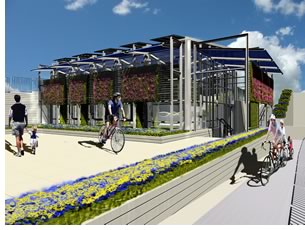

03/2005
Bicyclists are keen to pedal up
Tucked away in the northeast quadrant of Chicago’s Millennium Park, a 12,000-square-foot bicycle station is fast becoming the jewel of the park for many Chicagoans. Designed by Chicago-based Müller & Muller Architects for the Chicago Department of Transportation, this 300-bike parking/changing station quietly opened last summer amid the flourish of big-spectacle projects such as Frank Gehry’s band shell. However, since that time, the “Little Station that Could” has been operating at or near capacity and now has a lengthy waiting list for locker space.
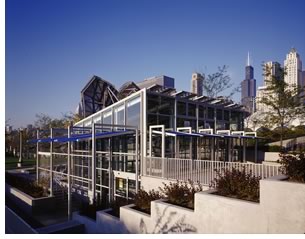 A tight schedule
A tight schedule
Funded by the Congestion Mitigation and Air Quality program, jointly
administered by the U.S. Department of Transportation’s Federal
Highway Administration and the Federal Transit Administration under
the TEA-21 Act, the station was designed to promote bicycle riding
to improve health and air quality in Chicago. According to David Steele,
AIA, Müller & Muller’s senior designer for the station,
the turnaround on this project was very tight: Design began two summers
ago, construction started last spring, and the station opened at the
beginning of July 2004. “We had a very short design schedule
and extremely short construction schedule, so everybody really had
to work well together. Initially, the entire bike station was meant
to be underground—it
wouldn’t be visible from above—but we thought that would
be a mistake. It needed a more attractive and official presence so
the people would know about it. It actually has become somewhat of
a landmark for bikers in Chicago.”
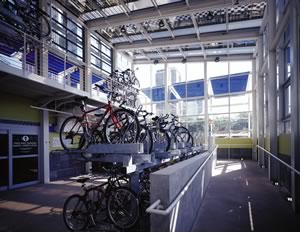 Built
on top of a garage underneath the park, the above-ground portion of the
bike station is the grand entrance of the facility. The glass curtain
wall and interior atrium welcomes cyclists and pronounces a public presence
for the site. The architect designed the atrium’s skin
to maximize energy efficiency and natural ventilation. The vertical surface
features “a series of stainless steel cables on which plantings
will eventually grow and climb to create more shielding,” notes
Steele. “In the summer, you’ll get a really leafy effect
on the building. As some of the leaves go away in the fall, the effect
will be more lacy and open, allowing a lot more sunlight in.”
Built
on top of a garage underneath the park, the above-ground portion of the
bike station is the grand entrance of the facility. The glass curtain
wall and interior atrium welcomes cyclists and pronounces a public presence
for the site. The architect designed the atrium’s skin
to maximize energy efficiency and natural ventilation. The vertical surface
features “a series of stainless steel cables on which plantings
will eventually grow and climb to create more shielding,” notes
Steele. “In the summer, you’ll get a really leafy effect
on the building. As some of the leaves go away in the fall, the effect
will be more lacy and open, allowing a lot more sunlight in.”
Although one of the goals of the project was to promote sustainable architecture in the city, the project is not LEED™-certified. This is largely due to the tight timeline, but also because LEED is primarily geared toward office buildings, making translation to this project type difficult. However, Steele notes that, based on an informal survey, they do believe that it would meet LEED certification criteria. Among the green features are 120 photovoltaic panels atop the building that produce a portion of the facility’s electricity, an amount equivalent to provide “enough power for 100 average American homes,” the architect says.
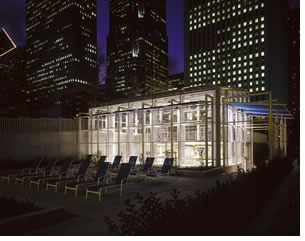 The price is right
The price is right
At the edge of Chicago’s famed “Loop,” the two-level
station is a draw for bicyclists, runners, and in-line skaters because
of its attractive design and setting and convenient downtown location
near mass transit, Lake Shore Drive, and a multitude of office buildings.
The first full-service bicycle station in Chicago, it offers free daily
bicycle parking and clean, bright, modern locker room facilities for
the minimal cost of $1 a day (monthly passes can be obtained for $15
and annual passes for $90). The Millennium Park Bicycle Station “not
only gives bicyclists a place to park, but more importantly, a place
to get cleaned up,” says Steele. “If you ride your bike to
work, especially in the summer, you get sweaty and don’t want to
go into the office like that, so there are showers and lockers to store
your things so you can be presentable at the office.”
 The
bikes are deposited on double-stacking racks with a “pull-out
lever that allows you to pull your bike up to the second level and push
it back in,” says Steele. “It’s fairly easy to use
even though they’re double-stacked.” The locker facilities
provide 240 lockers for monthly or annual users and 100 pay lockers.
The individual showers, four for both women and men, each has a personal
dressing area attached, eliminating the corral feel common to many fitness
center locker rooms. “An effort was made to give some personal
feeling to the place so it’s not like you’re going into a
big bullpen shower room.” Steele also notes that the facility
operator, Bike Chicago, would like to add more showers eventually. Although
the showers are accessible without a wait for most of the day, during
rush hour they can get backed up because most commuters arrive within
1–2 hours of each other.
The
bikes are deposited on double-stacking racks with a “pull-out
lever that allows you to pull your bike up to the second level and push
it back in,” says Steele. “It’s fairly easy to use
even though they’re double-stacked.” The locker facilities
provide 240 lockers for monthly or annual users and 100 pay lockers.
The individual showers, four for both women and men, each has a personal
dressing area attached, eliminating the corral feel common to many fitness
center locker rooms. “An effort was made to give some personal
feeling to the place so it’s not like you’re going into a
big bullpen shower room.” Steele also notes that the facility
operator, Bike Chicago, would like to add more showers eventually. Although
the showers are accessible without a wait for most of the day, during
rush hour they can get backed up because most commuters arrive within
1–2 hours of each other.
Steele notes that the popularity of the station has been somewhat surprising. There’s no real precedent for this project type in the U.S., so it was difficult to gauge how successful the project could be. “It’s more common in Europe. We really didn’t know how popular it would be, but there’s a strong contingent of bike riders in Chicago who even ride through the winter, and the city has put in bike lanes all over the place. The lakefront trail runs through the park and almost the entire length of the city, so there are some great opportunities for biking in Chicago.”
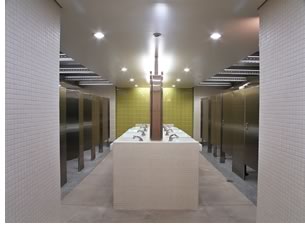 The Millennium Park Bike Station also provides
a home to the Chicago Police Lakefront Bicycle Patrol Unit, offering
excellent lakefront proximity for the police and additional security
for bicyclists. Essential to commuters and recreational enthusiasts
alike, the station supplies bicycle repair and rental and soon will
offer a small café featuring healthy
drinks and snacks. In addition, during special events in the park, the
station offers free valet parking, making it a viable option throughout
the seasons and at all hours of the day.
The Millennium Park Bike Station also provides
a home to the Chicago Police Lakefront Bicycle Patrol Unit, offering
excellent lakefront proximity for the police and additional security
for bicyclists. Essential to commuters and recreational enthusiasts
alike, the station supplies bicycle repair and rental and soon will
offer a small café featuring healthy
drinks and snacks. In addition, during special events in the park, the
station offers free valet parking, making it a viable option throughout
the seasons and at all hours of the day.
Copyright 2005 The American Institute of Architects.
All rights reserved. Home Page ![]()
![]()
 |
||
|
|
||
